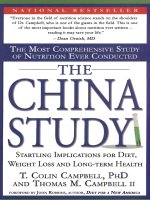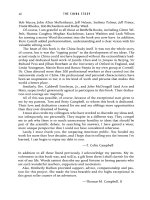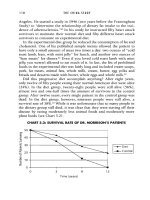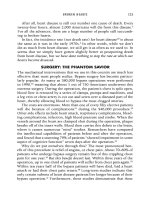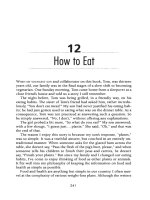66 the china study the most comprehensive phần 25
Bạn đang xem bản rút gọn của tài liệu. Xem và tải ngay bản đầy đủ của tài liệu tại đây (53.56 KB, 5 trang )
108
THE CHINA STUDY
ings to see what other researchers have found regarding diet and health.
As our research findings expanded from the specific to the general, the
picture has continued to enlarge. We now can look at the work of other
scientists to put my findings into a larger context. As you shall see, it is
nothing short of astonishing.
DISEASES OF AFFLUENCE
HERE IN AMERICA, we are affluent, and we die certain deaths because of it.
We eat like feasting kings and queens every day of the week, and it kills
us. You probably know people who suffer from heart disease, cancer,
stroke, Alzheimer's, obesity or diabetes. There's a good chance that you
yourself suffer from one of these problems, or that one of these diseases
runs in your family. As we have seen, these diseases are relatively unknown in traditional cultures that subsist mostly on whole plant foods,
as in rural China. But these ailments arrive when a traditional culture
starts accumulating wealth and starts eating more and more meat, dairy
and refined plant products (like crackers, cookies and soda).
In public lectures, I start my presentation by telling the audience
my personal story, just as I have done in this book. Invariably, I get a
question at the end of the lecture from someone who wants to know
more about diet and a specific disease of affluence. Chances are that you
yourself also have a question about a specific disease. Chances are, too,
that this specific disease is a disease of affluence, because that's what we
die of here in America.
You might be surprised to know that the disease that interests you
has much in common with other diseases of affluence, especially when
it comes to nutrition. There is no such thing as a special diet for cancer
and a different, equally special diet for heart disease. The evidence now
amassed from researchers around the world shows that the same diet
that is good for the prevention of cancer is also good for the prevention
109
I
110
THE CHINA STUDY
of heart disease, as well as obesity, diabetes, cataracts, macular degeneration, Alzheimer's, cognitive dysfunction, multiple sclerosis, osteoporosis and other diseases. Furthermore, this diet can only benefit everyone,
regardless of his or her genes or personal dispositions.
All of these diseases, and others, spring forth from the same influence: an unhealthy, largely toxic diet and lifestyle that has an excess of
sickness-promoting factors and a deficiency of health-promoting factors. In other words, the Western diet. Conversely, there is one diet to
counteract all of these diseases: a whole foods, plant-based diet.
The following chapters are organized by disease, or disease grouping.
Each chapter contains evidence showing how food relates to each disease. As you go through each chapter, you will begin to see the breadth
and depth of the astonishing scientific argument favoring a whole foods,
plant-based diet. For me, the consistency of evidence regarding such a
disparate group of diseases has been the most convincing aspect of this
argument. When a whole foods, plant-based diet is demonstrably beneficial for such a wide variety of diseases, is it possible that humans were
meant to consume any other diet? I say no, and I think you'll agree.
America and most other Western nations have gotten it wrong when
it comes to diet and health, and we have paid a grave price. We are sick,
overweight and confused. As I have moved on from the laboratory studies and the China Study and encountered the information discussed in
Part II, I have become overwhelmed. I have come to realize that some
of our most revered conventions are wrong and real health has been
grossly obscured. Most unfortunately, the unsuspecting public has paid
the ultimate price. In large measure, this book is my effort to right these
wrongs. As you will come to see in the following chapters, from heart
disease to cancer, and from obesity to blindness, there is a better path
to optimal health.
1
I
Jl
~
l
1
t
.. . . ... . ... . .... ... . . . .... . . . 5. . . . ..... . ... . ... . . . . ... ....
Broken Hearts
PUT YOUR HAND on your chest and feel your heart beat. Now put your
hand where you can feel your pulse. That pulse is the signature of your
being. Your heart, creating that pulse, is working for you every minute
of the day, every day of the year, and every year of your entire life. If you
live an average lifetime, your heart will beat about 3 billion times. l
Now take a moment to realize that during the time it took you to
read the above paragraph an artery in the heart of roughly one American
clogged up, cut off blood flow and started a rapid process of tissue and
cell death. This process is better known, of course, as a heart attack. By
the time you finish reading this page, four Americans will have had a
heart attack, and another four will have fallen prey to stroke or heart
failure.2 Over the next twenty-four hours, 3,000 Americans will have
heart attacks,2 roughly the same number of people who perished in the
terrorist attacks of September 11, 200l.
The heart is the centerpiece of life and, more often than not in America, it is the centerpiece of death. Malfunction of the heart and/or circulation system will kill 40% of Americans,3 more than those killed by any
other injury or ailment, including cancer. Heart disease has been our
number one cause of death for almost one hundred years. 4 This disease
does not recognize gender or race boundaries; all are affected. If you
were to ask most women what disease poses the greatest risk to them,
heart disease or breast cancer, many women would undoubtedly say
breast cancer. But they would be wrong. Women's death rate from heart
disease is eight times higher than their death rate from breast cancer. 5, 6
111
112
THE CHINA STUDY
If there is an "American" game, it is baseball; an "American" dessert,
apple pie. If there is an "American" disease, it is heart disease.
EVERYONE'S DOING IT
In 1950, Judy Holliday could be seen on the big screen, Ben Hogan
dominated the world of golf, the musical South Pacific won big at the
Tony Awards and on June 25, North Korea invaded South Korea. The
American administration was taken aback but responded quickly. Within days, President Truman sent in troops on the ground and bombers
overhead to push back the North Korean army. Three years later, inJuly
of 1953, a formal cease-fire agreement had been signed and the Korean
War was over. During this period of time, over 30,000 American soldiers were killed in battle.
At the end of the war, a landmark scientific study was reported in the
Journal of the American Medical Association. Military medical investigators had examined the hearts of 300 male soldiers killed in action in Korea. The soldiers, at an average age of twenty-two years, had never been
diagnosed with heart problems. In dissecting these hearts, researchers
found startling evidence of disease in an exceptional number of cases.
Fully 77.3% of the hearts they examined had "gross evidence" of heart disease.? (In this instance, "gross" means large.)
That number, 77.3%, is startling. Coming at a time when our number
one killer was still shrouded in mystery, the research clearly demonstrated that heart disease develops over an entire lifetime. Furthermore,
almost everyone was susceptible! These soldiers were not couch-potato
slouches; they were in top condition in the prime of their physical lives.
Since that time, several other studies have confirmed that heart disease
is pervasive in young Americans. s
THE HEART ATTACK
But what is heart disease? One of the key components is plaque. Plaque
is a greasy layer of proteins, fats (including cholesterol), immune system cells and other components that accumulate on the inner walls of
the coronary arteries. I have heard one surgeon say that if you wipe
your finger on a plaque-covered artery; it has the same feel as wiping
your finger across a warm cheesecake. If you have plaque building up
in your coronary arteries, you have some degree of heart disease. Of
the autopsied soldiers in Korea, one out of twenty diseased men had so
much plaque that 90% of an artery was blocked.? That's like putting a
